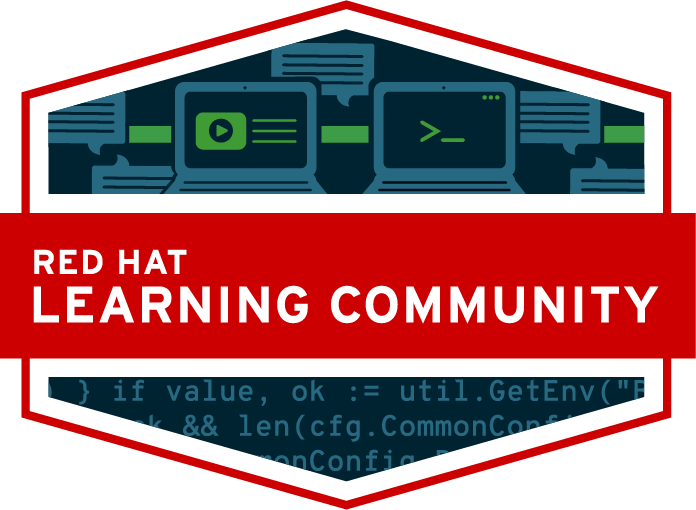- Red Hat Community
- :
- Explore
- :
- Red Hat Learning Community News
- :
- Red Hat Certified Engineer training and testing no...
Red Hat Certified Engineer training and testing now available on Red Hat Enterprise Linux 8
- Subscribe to RSS Feed
- Mark as New
- Mark as Read
- Bookmark
- Subscribe
- Printer Friendly Page
- Report Inappropriate Content
The newly released Red Hat Certified Engineer (RHCE) exam (EX294) updated to Red Hat Enterprise Linux 8 allows candidates to demonstrate they have the skills to manage and configure multiple systems using state of the art automation tools. Including Red Hat Ansible Engine in this test came as a result of increasingly more IT organizations facing challenges related to scaling infrastructure and efficiently turning to Red Hat Ansible Automation as a common language to automate across different functions. As a result, system administrators need to understand more than how to deploy, configure, and manage an operating system—they need to know how to automate functions and how to make the automation itself scalable.
By shifting the focus of RHCE to the automation of system administration tasks—principally using Red Hat Ansible Automation—we are reflecting the current reality for progressive organizations and the coming reality for the technology industry.
The exam focuses on the automation of Linux system administration tasks using Ansible and shell scripting and using Ansible Engine to perform common systems administration tasks in a multi-system environment. Specific skills tested include:
- Work with core components of Ansible such as modules, variables and plays
- Install and configuring an Ansible control node
- Configure Ansible managed nodes
- Run ad-hoc Ansible commands
- Work with inventories
- Create Ansible plays and playbooks
- Use Ansible modules for system administration tasks
- Create and using templates to create customized configuration files
- Work with Ansible variables and facts
- Create and working with roles
- Use Ansible Vault
To aid in the learning journey, the Red Hat Training team created Red Hat System Administration III: Linux Automation (RH294) to teach system administrators and developers who need to automate provisioning, configuration, application deployment, and orchestration. Students will also learn how to install and configure Ansible on a management workstation; prepare managed hosts for automation; write Ansible Playbooks to automate tasks; and run playbooks to ensure servers are correctly deployed and configured.
Find out where you are in your RHEL 8 learning journey by completing a Linux Skills Assessment or downloading our free Red Hat Enterprise Linux Technical Overview (RH024).
You must be a registered user to add a comment. If you've already registered, sign in. Otherwise, register and sign in.
-
100K
2 -
25k members
1 -
Agile practices
1 -
Ansible
2 -
Ansible Training
1 -
automation
1 -
Award
1 -
Badges
1 -
Best advance in social learning
1 -
Brandon Hall
1 -
Certification
13 -
Certification Resources
1 -
containers
1 -
contest
5 -
Culture
1 -
DevOps
2 -
DevOps training
1 -
DO180
1 -
DO500
3 -
Early Access
1 -
education
1 -
Exam Announcement
1 -
Exams
2 -
Free Tier
1 -
Intro to OpenShift
1 -
Introduction to OpenShift
1 -
Learn
1 -
level up hour
1 -
linux
4 -
Linux Training
1 -
mastery contest series
1 -
OCP
1 -
OCP 4
1 -
OCP4
1 -
Openshift
2 -
OpenShift 4
1 -
Power Training
3 -
Preliminary Exams
1 -
Red Hat
13 -
Red Hat Academy
3 -
Red Hat Certified Engineer
1 -
Red Hat Certified Professional
1 -
Red Hat Certified System Administrator
1 -
red hat enterprise linux
2 -
Red Hat Learning
1 -
red hat learning community
5 -
Red Hat Learning Subscription
4 -
Red Hat Services
1 -
Red Hat Summit
2 -
Red Hat Training
9 -
Release
1 -
Remote
1 -
RHA
2 -
RHCE
2 -
RHCP
3 -
RHCP of the Year
1 -
RHCPoY
2 -
RHCSA
3 -
RHEL
7 -
RHEL 8
5 -
RHLS
4 -
students
1 -
Summit
7 -
Training
13 -
Training & Certification
2 -
Training and Certification
2 -
Video Classroom
1 -
webinar
2
- « Previous
- Next »

Red Hat
Learning Community
A collaborative learning environment, enabling open source skill development.

